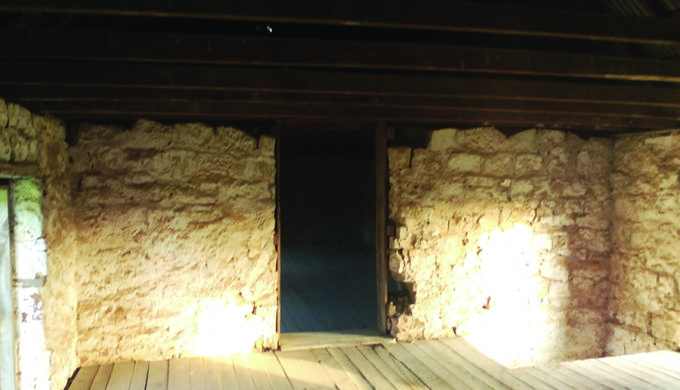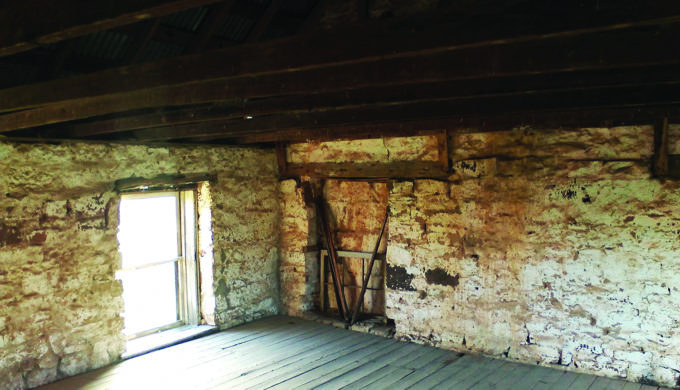Photo:
Charles F. Konvicka, The Bohemian Farmer with the Car in the Barn.
In 1911, James E. Odiorne sold the Bluebonnet House to Charles F. Konvicka. Charles was born in Austria in 1869, and his wife Anna Mican Konvicka was born in 1870, also in Austria.
The 1900 Lavaca County Census shows Charles as a farmer, the couple’s marriage date as 1891, and they had five children. The 1910 Census, in the same county, shows that they then had 10 children, immigrated into the United States in 1885, and all spoke English except for Anna.
The Konvickas occupied the Bluebonnet House as their homestead as Charles continued his occupation as a farmer. When they in Burnet County, they told their neighbors that they were from Gonzales, Texas. That could be true, despite the 1910 Census information. That area of Texas, including Gonzales and Hallettsville, had a large population of Bohemians and also Czechs.
Charles appears for the last time the 1930 Burnet County Census. He died in September of that year. He was buried south of the Bluebonnet House also where P. L. Hubbard and two of the Cavins lie. Anna died in 1956 and was likewise buried there. Their oldest son, Charles Jr. or Charly, died in 1928, and lies beside his parents. In 1940, Anna along with children Anton, Angeline, and Vincent are listed as occupying the same house together.
It was stated that the Konvickas probably felt a bit isolated from their neighbors, as they were Catholic, and there were very few Catholics in Burnet County at the time. The Catholic Church in Burnet was founded in the late 1930s, and the Catholic Church in Marble Falls was not founded until 1961.
There is one story regarding Charles and his automobile. Sometime, probably in the early 1920s, Charles bought a car but refused to get a driver’s license, nor plates, for the car. So, two of his sons put the car up on blocks in the barn and the tires and wheel rims up in the loft. And there the parts stayed for a good while. The barn now located just north of the old rock house is constructed from the lumber from the old two-story barn, which was located somewhere to the east of the house.
Helen Konvicka Graham from Llano gave the current owner the information about the car in the barn, and also stated that there were two more cabins located on the property, probably somewhere southwest of the main house. Helen died in 1995 and is buried in the Fairland Cemetery, northwest of Marble Falls. Helen stated that some of the family referred to themselves as “the crazy Bohemians.” The last of the family living in the house was Angeline, who never married. After her death in 1973, it appears that the house remained vacant, until the current owner bought it in 1976 at an estate sale.
Gladys Atkinson, The Current Owner.
Gladys Atkinson is the present owner of the Bluebonnet House. She has stated that the current wooden floors, except for the kitchen area, date from about 1910. When she and her late husband bought the property, they did not live in Marble Falls, and they spent many a weekend cleaning out the house. They became the owners of two metal double beds with wheels, made in the Czech Republic. The beds had heavy canvas bags for the mattresses, stuffed with corn shucks.
They also inherited a kitchen cupboard and a pie safe. She removed the P. L. Hubbard tombstone and took it to her residence, as it was weathering very badly. Her current aim is to document the history of the house as completely as possible. She and her children have researched the subject for several years, and interviewed neighbors and anyone who could tell her about the property. She and her family have high hopes of getting the house restored as soon as possible. Her grandchildren want to open the house up to tourists and bluebonnet aficionados and include a gift shop and information about the house and all its owners. There is no doubt that the house and its surroundings have a bright future and a long life ahead.
UPDATE (April 15, 2019): We were deeply sorry to learn about the recent passing of the bluebonnet house’s owner Gladys Atkinson. Our thoughts and prayers are with her family.






